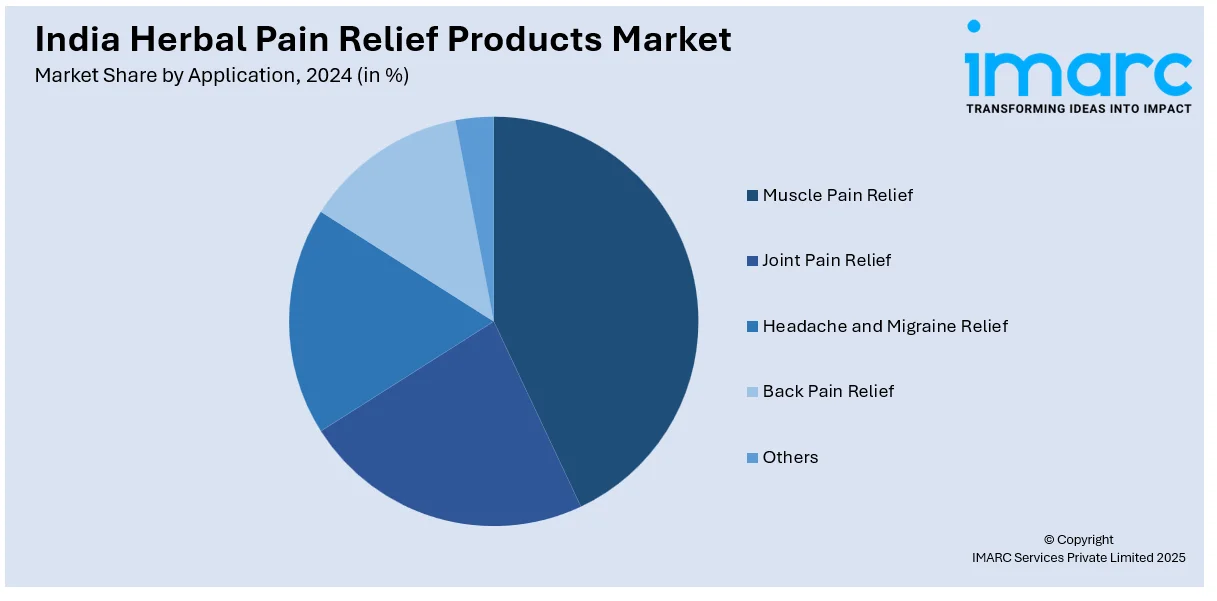
India Herbal Pain Relief Products Market Size, Share, Trends and Forecast by Product Type, Ingredient Type, Application, Distribution Channel, End User and Region, 2025-2033
India Herbal Pain Relief Products Market Size and Share:
The India herbal pain relief products market size reached USD 722.7 Million in 2024. Looking forward, IMARC Group expects the market to reach USD 2,680.0 Million by 2033, exhibiting a growth rate (CAGR) of 14.50% during 2025-2033. The market is fueled by the growing consumer preference for natural, chemical-free remedies, increasing awareness regarding the benefits of herbal drugs, and rising focus on wellness. Also, growth in online retailing platforms and demand for alternate therapies further propel the India herbal pain relief products market share.
|
Report Attribute
|
Key Statistics
|
|---|---|
|
Base Year
|
2024
|
|
Forecast Years
|
2025-2033
|
|
Historical Years
|
2019-2024
|
| Market Size in 2024 | USD 722.7 Million |
| Market Forecast in 2033 | USD 2,680.0 Million |
| Market Growth Rate 2025-2033 | 14.50% |
India Herbal Pain Relief Products Market Trends:
Growing Demand for Natural Pain Relief Solutions
The India herbal pain relief products market outlook is experiencing a major transition toward organic and natural products as consumers are becoming increasingly health conscious. Most individuals are shifting away from chemical-based painkillers because of side effects and long-term health concerns. Herbal remedies such as turmeric, ashwagandha, and eucalyptus are becoming increasingly popular for their pain-relieving and anti-inflammatory properties. Ayurvedic painkillers in the form of oils, balms, and capsules are being promoted as safer and non-habit-forming options. The trend is fueled by higher awareness on social media platforms and the evolution of wellness-conscious influencers. Moreover, the increased popularity of alternative medicine and traditional healing practices has fueled demand, especially among middle- and upper-middle-class segments. As such, existing companies as well as new ventures are coming up with innovative formulations to serve this growing market. As per industry reports, over 1,000 Ayush manufacturers are recognized by the state government in Madhya Pradesh, stated the association of manufacturers of herbal and ayurvedic products, noting that more than 100 of these manufacturers have expanded their operations into international markets in response to rising demand. While Indore hosts around 200 units that produce ayurvedic medicine, and the overall market size is projected to surpass Rs 1,000 crore, as per the Ayush Nirmata Sangh.

To get more information on this market, Request Sample
Rise in E-commerce and Online Sales
The growth of e-commerce in India has contributed significantly to the India herbal pain relief products market growth. Shoppers are increasingly opting to shop online with the convenience, price competitiveness, and variety offered by online sites. With an increasing number of Indians accessing the internet, the earnings of e-commerce firms may soar threefold within the next three years to reach 504 billion rupees (USD 8.13 billion). Online marketplaces such as Amazon, Flipkart, and niche herbal product sites have facilitated convenient access to such products from both urban and rural locations. The convenience of buying herbal pain relief products over the internet, along with door-step delivery, has helped to boost this segment. E-commerce also offers an opportunity for brands to interact with consumers directly, gain their trust, and make them aware of the advantages of natural pain relief options. Online consultation with wellness professionals and the growing presence of customer reviews also influences buying decisions. With growing internet penetration, even more individuals are likely to search for and buy herbal treatments on the internet.
Expansion of Product Offerings and Customization
India's market for herbal pain relief is placing more emphasis on product development and providing customized solutions. Classic herbal products in the form of oils, balms, and tablets are supplemented today with contemporary forms like sprays, gels, and creams to facilitate ease of application and faster relief. Some firms are also providing customized pain management solutions based on a person's specific requirements, for example, addressing muscle pain, joint pain, or migraine. The trend toward personalization is driven by innovation in research and development, as manufacturers apply scientific principles to make herbal products more effective. Consumers are also seeking multi-benefit products, with pain relief coupled with other health benefits like stress relief, circulation improvement, and sleep improvement. While consumer preferences change and grow, brands are seeking to produce specialized products for specific groups, such as athletes, elderly people, or office workers, and therefore expand their customer base.
India Herbal Pain Relief Products Market Segmentation:
IMARC Group provides an analysis of the key trends in each segment of the market, along with forecasts at the regional level for 2025-2033. Our report has categorized the market based on product type, ingredient type, application, distribution channel, and end user.
Product Type Insights:
- Oils and Balms
- Tablets and Capsules
- Powders
- Patches and Gels
- Sprays and Roll-Ons
- Others
The report has provided a detailed breakup and analysis of the market based on the product type. This includes oils and balms, tablets and capsules, powders, patches and gels, sprays and roll-ons, and others.
Ingredient Type Insights:
- Turmeric
- Ashwagandha
- Ginger
- Eucalyptus
- Menthol
- Others
The report has provided a detailed breakup and analysis of the market based on the ingredient type. This includes turmeric, ashwagandha, ginger, eucalyptus, menthol, and others.
Application Insights:

- Muscle Pain Relief
- Joint Pain Relief
- Headache and Migraine Relief
- Back Pain Relief
- Others
The report has provided a detailed breakup and analysis of the market based on the application. This includes muscle pain relief, joint pain relief, headache and migraine relief, back pain relief, and others.
Distribution Channel Insights:
- Online
- Offline
The report has provided a detailed breakup and analysis of the market based on the distribution channel. This includes online and offline.
End User Insights:
- Adults
- Elderly
- Sports and Fitness Enthusiasts
The report has provided a detailed breakup and analysis of the market based on the end user. This includes adults, elderly, and sports and fitness enthusiasts.
Regional Insights:
- North India
- South India
- East India
- West India
The report has also provided a comprehensive analysis of all the major regional markets, which include North India, South India, East India, and West India.
Competitive Landscape:
The market research report has also provided a comprehensive analysis of the competitive landscape. Competitive analysis such as market structure, key player positioning, top winning strategies, competitive dashboard, and company evaluation quadrant has been covered in the report. Also, detailed profiles of all major companies have been provided.
India Herbal Pain Relief Products Market News:
- In September 2023, Himalaya Wellness Company revealed a new television advertising campaign for Rumalaya Active Spray, focused on delivering consumers fast and enduring pain relief. The theme of the campaign, "Rumalaya Active Spray: Your Partner in Pain Relief," highlights Himalaya's dedication to providing clinically validated, safe, and effective pain relief that endures for up to six hours.
India Herbal Pain Relief Products Market Report Coverage:
| Report Features | Details |
|---|---|
| Base Year of the Analysis | 2024 |
| Historical Period | 2019-2024 |
| Forecast Period | 2025-2033 |
| Units | Million USD |
| Scope of the Report |
Exploration of Historical Trends and Market Outlook, Industry Catalysts and Challenges, Segment-Wise Historical and Future Market Assessment:
|
| Product Types Covered | Oils and Balms, Tablets and Capsules, Powders, Patches and Gels, Sprays and Roll-Ons, Others |
| Ingredient Types Covered | Turmeric, Ashwagandha, Ginger, Eucalyptus, Menthol, Others |
| Applications Covered | Muscle Pain Relief, Joint Pain Relief, Headache and Migraine Relief, Back Pain Relief, Others |
| Distribution Channels Covered | Online, Offline |
| End Users Covered | Adults, Elderly, Sports and Fitness Enthusiasts |
| Regions Covered | North India, South India, East India, West India |
| Customization Scope | 10% Free Customization |
| Post-Sale Analyst Support | 10-12 Weeks |
| Delivery Format | PDF and Excel through Email (We can also provide the editable version of the report in PPT/Word format on special request) |
Key Questions Answered in This Report:
- How has the India herbal pain relief products market performed so far and how will it perform in the coming years?
- What is the breakup of the India herbal pain relief products market on the basis of product type?
- What is the breakup of the India herbal pain relief products market on the basis of ingredient type?
- What is the breakup of the India herbal pain relief products market on the basis of application?
- What is the breakup of the India herbal pain relief products market on the basis of distribution channel?
- What is the breakup of the India herbal pain relief products market on the basis of end user?
- What is the breakup of the India herbal pain relief products market on the basis of region?
- What are the various stages in the value chain of the India herbal pain relief products market?
- What are the key driving factors and challenges in the India herbal pain relief products market?
- What is the structure of the India herbal pain relief products market and who are the key players?
- What is the degree of competition in the India herbal pain relief products market?
Key Benefits for Stakeholders:
- IMARC’s industry report offers a comprehensive quantitative analysis of various market segments, historical and current market trends, market forecasts, and dynamics of the India herbal pain relief products market from 2019-2033.
- The research report provides the latest information on the market drivers, challenges, and opportunities in the India herbal pain relief products market.
- Porter's five forces analysis assist stakeholders in assessing the impact of new entrants, competitive rivalry, supplier power, buyer power, and the threat of substitution. It helps stakeholders to analyze the level of competition within the India herbal pain relief products industry and its attractiveness.
- Competitive landscape allows stakeholders to understand their competitive environment and provides an insight into the current positions of key players in the market.
Need more help?
- Speak to our experienced analysts for insights on the current market scenarios.
- Include additional segments and countries to customize the report as per your requirement.
- Gain an unparalleled competitive advantage in your domain by understanding how to utilize the report and positively impacting your operations and revenue.
- For further assistance, please connect with our analysts.
 Request Customization
Request Customization
 Speak to an Analyst
Speak to an Analyst
 Request Brochure
Request Brochure
 Inquire Before Buying
Inquire Before Buying




.webp)




.webp)












